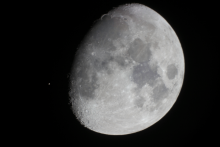Listen to today's episode of StarDate on the web the same day it airs in high-quality streaming audio without any extra ads or announcements. Choose a $8 one-month pass, or listen every day for a year for just $30.
You are here
Moon and Aldebaran
Christmas Eve night gets off to a beautiful start. The gibbous Moon pairs up with Aldebaran, the bright star that marks the eye of the celestial bull. Aldebaran will be a bit farther from the Moon as they set, before dawn.
Aldebaran is a fairly close neighbor — a bit more than down the block, but certainly on the next block over. It’s a bit more than 65 light-years away. That means the light we see from Aldebaran tonight, traveling at 670 million miles per hour, actually left the star 65 years ago — in 1958. And the light it beams into space tonight won’t get here until early 2089.
The star shouldn’t look any different then than it does right now. It’s late in life, so it’s changing much faster than the Sun is. Yet none of those changes are noticeable over a human lifetime — or even many lifetimes.
Still, it is changing. Eventually, its outer layers of hot gas will flow out into space. For thousands of years, they’ll surround Aldebaran with a colorful bubble of gas — a structure where changes can be seen over just a few years. Then the bubble will fade away, leaving only the star’s hot, dead core — the corpse of mighty Aldebaran.
The Moon will huddle even closer to another of the bull’s star’s tomorrow night — part of the beautiful sky of Christmas night.
Script by Damond Benningfield



